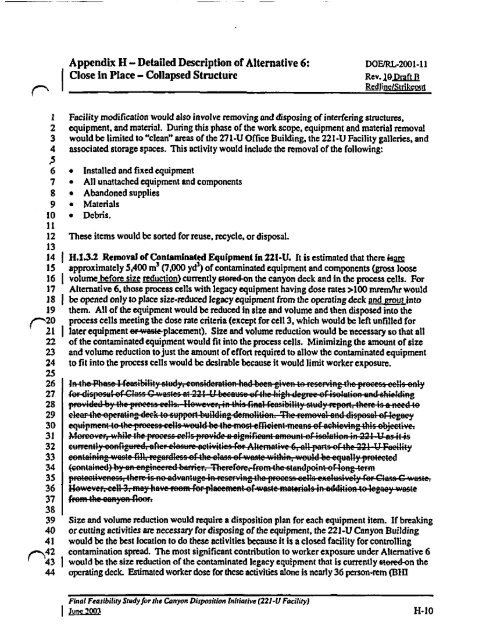View Document Here - Hanford Site
View Document Here - Hanford Site
View Document Here - Hanford Site
Create successful ePaper yourself
Turn your PDF publications into a flip-book with our unique Google optimized e-Paper software.
Appendix H - Detailed Description of Alternative 6: DOFJItI.-2001-11<br />
Close in Place - Collapsed Structu're itev..Ita DraU<br />
Rcd1ins1S1rikssxn<br />
1 Facility modification would also involve removing and disposing of interfering structures,<br />
2 equipment, and material. During this phase of the work scope, equipment and material removal<br />
3 would be limited to "clean" areas of the 271-U Office Building, the 221-U Facility galleries, and<br />
4 associated storage spaces. This activity would include the removal of the following:<br />
.5 6 • Installed and fixed equipment<br />
7 • All unattached equipment and components<br />
8 • Abandoned supplies<br />
9 • Materials<br />
10<br />
11<br />
• Debris.<br />
12<br />
13<br />
These items would be sorted for reuse, recycle, or disposal.<br />
14 H.1.3.2 Removal of Contaminated Equipment in 221-LJ it is estimated that there isgrc<br />
15<br />
16<br />
17<br />
18<br />
19<br />
(^-120<br />
21<br />
22<br />
23<br />
approximately 5,400 m3 (7,000 yd) of contaminated equipment and components (gross loose<br />
volume before size reduction currently 6toFed-on the canyon deck and in the process cells. For<br />
Alternative 6, those process cells with legacy equipment having dose rates >100 mrcm/hr would<br />
be opened only to place size-reduced legacy equipment from the operating deck and prour into<br />
them. All of the equipment would be reduced in size and volume and then disposed into the<br />
process cells meeting the dose rate criteria (except for cel13, which would be left unfilled for<br />
later equipment or-waste-placement). Size and volume reduction would be necessary so that all<br />
of the contaminated equipment would fit into the process cells. Minimizing the amount of size<br />
and volume reduction to just the amount of effort required to allow the contaminated equipment<br />
24<br />
25<br />
to fit into the process cells would be desirable because it would limit worker exposure.<br />
26 Ia t he-preeess-eelis-enFy<br />
27<br />
nd+kietding<br />
28<br />
,'<br />
29<br />
30<br />
31<br />
32<br />
33<br />
34<br />
35<br />
36<br />
37<br />
38<br />
0 0<br />
39<br />
40<br />
Size and volume reduction would require a disposition plan for each equipment item. If breaking<br />
or cutting activities are necessary for disposing of the equipment, the 221-U Canyon Building<br />
41 would be the best location to do these activities because it is a closed facility for controlling<br />
42 contamination spread. The most significant contribution to worker exposure under Alternative 6<br />
" 43 1 would be the size reduction of the contaminated legacy equipment that is currently •tered-on the<br />
44 operating deck. Estimated worker dose for thcse activities alone is nearly 36 person-rem (BHI<br />
Final Feasibility Stady jor the Canyon Disposition lnhiative (221-U Facility)<br />
Iunc ?OOl H-10

















